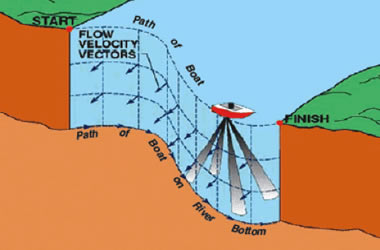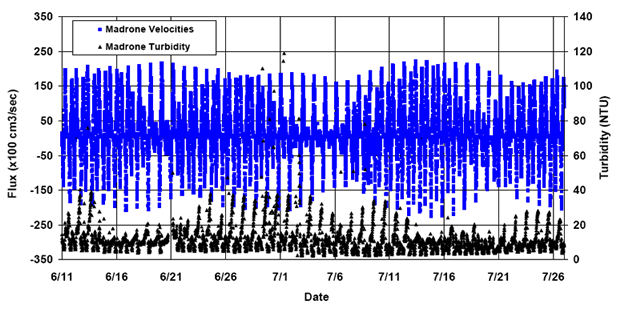Monitoring Methods
Hydrology
- Continuous Water Level
- Continuous Water Quality
- Discrete Water Quality
- Nutrients and Primary Productivity
- Flow and Hydrodynamics
Join the Discussion
Hydrology: Flow and Hydrodynamics

Physical processes in estuaries such as inundation, salinity variation, and water circulation patterns are dynamic. Along with freshwater inputs, the rise and fall of tides are the medium of energy exchange in estuary systems. River and tidal currents carry nutrients and sediment, create elevational and salinity gradients, and provide access to the marsh for fish and other aquatic organisms.
Methods used to examine the processes that affect transport and mixing of these waters range from periodic discharge measurements using a float and stopwatch to more advanced hydroacoustic instruments. Mechanical style meters (e.g. Price AA or Pygmy), often used in freshwater streams, are not applicable to tidal channels where saline conditions would short the meter signal and unsteady flows would also make it impractical. Therefore, hydroacoustic methods are preferred in tidal channels to measure the flow of water under a range of tide and flow conditions, and also to continuously monitor water velocity. Hydroacoustic instruments, often referred to as Acoustic Doppler Current Profilers (ADCPs), use principals of sound propagation through water--specifically changes in frequency referred to as Doppler shifts--to measure continuous water level, water current velocities (speed and direction) and acoustic backscatter (related to the concentration of suspended particles) throughout the water column. ADCPs can be mounted to the bottom of a tidal channel or to the bottom of a boat.
Measurement Methods
Hydroacoustic measurements require specialized instrumentation. Follow product guidelines and published measurement protocols. The following are company websites that manufacture acoustic velocity meters and ADCP’s:
- Nortek www.nortekusa.com/usa/products
- SonTek/YSI www.sontek.com
- Teledyne RD Instruments www.rdinstruments.com
Data Entry and Analysis
Below is the example of the type of output from an ADCP:

References
For more background information on streamflow measurements, check out this website by USGS: http://ga.water.usgs.gov/edu/measureflow.html
For more on ADCPs, check out this information page by Woods Hole Oceanographic Institution: http://www.whoi.edu/instruments/viewInstrument.do?id=819
Fagherazzi, Sergio 2008. Geomorphic structure of tidal hydrodynamics in salt marsh creeks. Water Resources Research 44(2).
Hood, W. G. 2002a. Landscape allometry: From tidal channel hydraulic geometry to benthic ecology. Canadian Journal of Fisheries and Aquatic Sciences 59:1418–1427.
Temmerman, S., T. J. Bouma, G. Govers, and D. Lauwaet 2005. Flow paths of water and sediment in a tidal marsh: relations with marsh developmental stage and tidal inundation height. Estuaries 28(3): 338 – 352.
Torres, Raymond 2007. Effects of topographic structure on salt marsh currents. Journal of Geophysical Research 112(f2).
U. S. EPA 1997. Volunteer stream monitoring: a methods manual. EPA 841-B-97-003. November U. S. Environmental Protection Agency, Office of Wetlands, Oceans & Watersheds, 4503F, Washington, DC 20460
